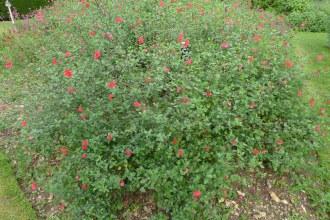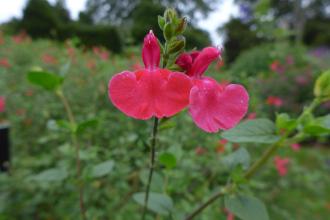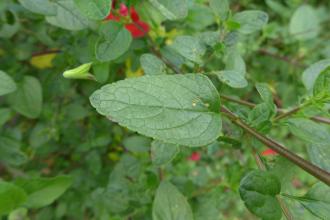
Salvia microphylla (04/10/2015, Kingston Maurward Gardens, Dorchester)
Position: Full sun
Flowering period: Late summer to autumn
Soil: Moist, well drained
Eventual Height: 1.2m
Eventual Spread: 1.2m
Hardiness: 7b, 8a, 8b, 9a, 9b, 10a, 10b
Family: Lamiaceae
Salvia microphylla is a semi evergreen sub shrub with a bushy habit . Its mid green leaves are ovate with slightly serrate margins, up to 8cm long and 4cm across. Its leaves are fragrant when crushed. Its pink two lipped flowers appear as terminal racemes.

Salvia microphylla Flower (04/10/2015, Kingston Maurward Gardens, Dorchester)
Salvia microphylla, commonly known as Baby Sage, Graham’s Sage or Blackcurrant Sage, is native to south Arizona and mountainous regions of Mexico.
The etymological root of the binomial name Salvia is derived from the Latin salvare meaning to ‘save’ or ‘heal’, in reference to its historical use as a medicinal plant. Microphylla is derived from the Greek mikro meaning ‘small’ and phyllon meaning ‘leaf’.
The landscape architect may find Salvia microphylla useful as park of a mixed herbaceous type planting scheme. Once established this plant is drought tollerant. It prefers a sheltered location.
Ecologically, Salvia microphylla flowers are attractive to pollinating insects, including bees and butterflies.

Salvia microphylla Leaf (04/10/2015, Kingston Maurward Gardens, Dorchester)
The Royal Horticultural Society have given a number of Salvia microphylla cultivars their prestigious Award of Garden Merit.
Salvia microphylla prefers moist, fertile, well-drained soils. It tolerates most pH of soil.
Salvia microphylla requires little maintenance. The removal of old flower heads with promote new flowering. To keep a compact habit this plant may be cut back in late spring.

Landscape Architecture

